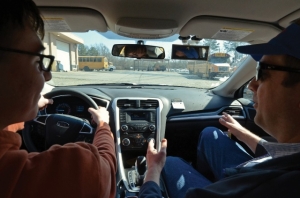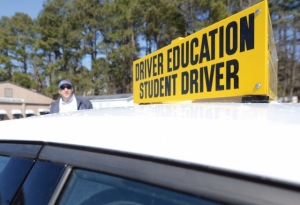Driver's education facing funding cuts
By Phyllis Moore
Published in News on February 22, 2015 1:50 AM

News-Argus/CASEY MOZINGO
Craig Uzzell, right, owner of A Plus Driving School, gives driving instructions to student Nick Froats. �

News-Argus/CASEY MOZINGO
Driver's ed is in jeopardy of losing state funding if the General Assembly pushes through legislation this summer.
If the General Assembly pushes through legislation this summer to end state funding for driver education classes for schools, the consequences will be more than financial, local officials say.
"It's going to affect everybody that drives a vehicle," said Jim Bennett, owner of Quality Driving School Inc., one of two businesses contracted through the school system to provide the service for students.
According to the proposal the driver education program administered by the state Department of Public Instruction will no longer be paid out of the Highway Fund based on an appropriation by the General Assembly. Instead, it would be placed in the hands of local school boards, which could charge a fee of up to $65 to offset costs of providing training and instruction. It could also result in parents having to foot the bill, an estimated fee of $300 to $350.
Last year, 106,000 students across the state took driver's ed, said Beverly Boltinhouse, finance officer for Wayne County Public Schools. Locally, an average of 1,500 students have enrolled in the course each year.
Historically, the district has never charged for the program.
"We are one of 45 units that do not charge a fee," Mrs. Boltinhouse said. "There are 70 (local education agencies) that charge something."
Bennett, certified as a driver's ed teacher in 1965, began during the era when schools had full-time driver's ed teachers.
"Driver's ed came out of the schools in 1991," he said. "That's when we started the business."
Since that time, instead of incorporating the classes into the school day or folding them into a health or physical education unit, the classes are offered after school or on Saturdays.
Bennett recalled when the Department of Motor Vehicles designated funds to the school program.
"When you bought your license, $3 of that charge was added in 1957 to go for driver's ed," Bennett said. "It's still in there. Highway safety is what lawmakers had in mind in 1957. The question in debate is whether the money (still) goes to driver's ed. The state comptroller should be able to project when that money began going somewhere else."
Paying for the program is not the only reason Bennett and Craig Uzzell, who operates A Plus Driving School, are anxiously awaiting the lawmakers' decision.
"If it's not funded, first of all, a lot of kids will opt out of the program. They won't have the experience behind the wheel. They'll likely wait until they're 18, when they can legally go and get a license, without having to have had the six hours of driving," Uzzell said. "I teach roughly 400 kids a year. If they have to pay full price, we may have 100 kids take it because (others) would just wait."
Bennett put it more bluntly.
"For what it's worth, if you were in school right now and you had to choose between spending your money to put your child in driver's ed or have them get an iPad, which one do you think they'll get?" he asked.
Technology and all the devices accessible to youth have become an "addiction," he said, citing examples of having to remove students from driver's ed because of the distraction.
Students benefit from the class time, Bennett said -- they learn about the terminology, the signs and the basic rules and laws involved in transportation.
Uzzell agreed that driver's education is a valuable program -- especially since the state introduced the graduated license program. Students can start the program at age 14 1/2, obtain a permit at 15 and their license at 16.
"You have to have your permit for one full year," he explained.
Receiving the six hours of classroom time and 12 hours of practice driving allows students to have a better foundation behind the wheel, he said.
"My concern is this," Bennett said. "If you have a student that has never been exposed to the classroom behind a wheel, you're dealing with a different individual."
One thing he does not do as a driver's ed teacher is mince words, he said.
"I can tell you stories. You wouldn't forget them," he said. "I'm talking about true life -- faces through the window, a man that was scalped when a VW got hit by a train right up there by Berkeley Boulevard," he said. "I tell them. I describe it. (Students) have talked about me on Facebook."
He has been called "that mean man" and confronted by parents for being "too graphic" in class, but he maintains there is a reason behind his approach.
"They have got to realize if you get distracted, it may be the last time you get distracted," he said. "The No. 1 killer on the highway between age 15 and 25 is a motor vehicle."
The "dark side" of teen driving is a stark reality and Bennett takes his role of instilling safe habits very seriously.
"Teen drivers, they have got to see there's a dark side," he said. "This is not a video game. You crash a car, boom. The car reappears. That's not real life. You crash (and) you could die."
Bennett shudders to think what will happen if driver's ed is no longer available to future drivers.
"The children need a foundation," he said. "You don't make them a professional driver -- six hours in the class, 12 in the car, then they're turned over to a parent. They're going to teach them everything they know, work with them a year. Who's going to influence them the most? At least they'll have a foundation from driver's ed."
Bennett understands that funding sources are limited, so he encourages parents to get involved in the process by talking to their congressmen and representatives.
"It's going to blow up. It's either going to go and make a big mushroom and the General Assembly realizes they have got to re-fund it somewhere or pass a bill that driver's ed is no longer required to get a learner's permit," Bennett said.
